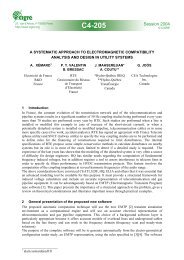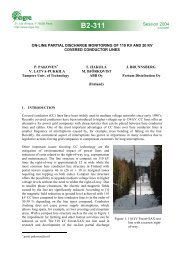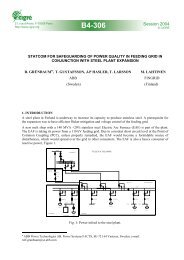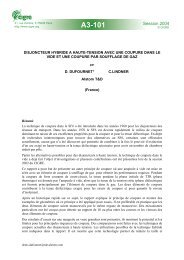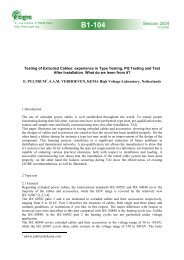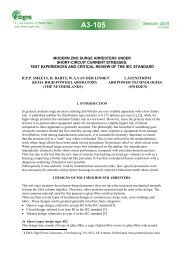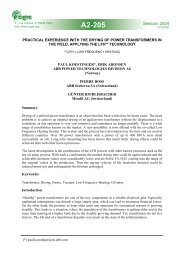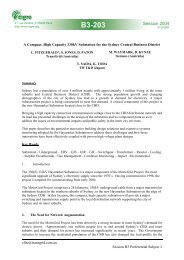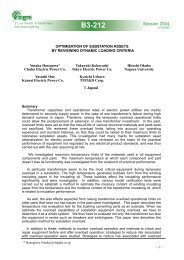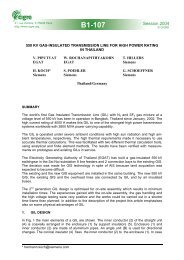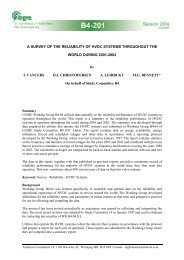Testing and loss measurement of HV shell-type shunt-reactors at ...
Testing and loss measurement of HV shell-type shunt-reactors at ...
Testing and loss measurement of HV shell-type shunt-reactors at ...
- No tags were found...
Create successful ePaper yourself
Turn your PDF publications into a flip-book with our unique Google optimized e-Paper software.
The resonance curve has a very high Q-factor determined mainly by the reactor <strong>and</strong> step-uptransformer <strong>loss</strong>. A r<strong>at</strong>io <strong>of</strong> the reactive <strong>and</strong> <strong>loss</strong> power is approxim<strong>at</strong>ely 500:1, <strong>and</strong> the resonancecharacteristic has a very steep slope in the oper<strong>at</strong>ing range. This results in a vari<strong>at</strong>ion <strong>of</strong> the testvoltage caused by power frequency fluctu<strong>at</strong>ion <strong>of</strong> approxim<strong>at</strong>ely ±0.3Hz in the supply <strong>of</strong> the gener<strong>at</strong>ordriving motor. The test frequency vari<strong>at</strong>ion is nearly three times higher, <strong>and</strong> the working point <strong>of</strong> theresonant test circuit moves by ±1Hz during one-hour test.To <strong>at</strong>tain the test voltage on the examined <strong>shunt</strong> reactor the resonant test-circuit power must be ~ 40times higher than the power available from the gener<strong>at</strong>or. On another h<strong>and</strong>, loading the gener<strong>at</strong>or withthe capacitive load may result in an uncontrolled spinning <strong>and</strong> destruction <strong>of</strong> the rot<strong>at</strong>ing machine. Forthis reason, an utmost care shall be taken to oper<strong>at</strong>e the test circuit on the inductive load side <strong>of</strong> theresonance curve. In consequence, the test frequency has to be confined in a narrow oper<strong>at</strong>ing-rangeth<strong>at</strong> is limited by the test-circuit resonant frequency <strong>and</strong> by the lowest frequency <strong>at</strong> which the testvoltage is <strong>at</strong>tained. A final tuning <strong>of</strong> the resonant test-circuit was performed by changing regul<strong>at</strong>iontaps <strong>of</strong> the step-up transformer, <strong>and</strong> by connecting or disconnecting capacitors from each level <strong>of</strong> thecompens<strong>at</strong>ion bank. This was somewh<strong>at</strong> tedious procedure, but unavoidable since no regul<strong>at</strong>edfrequencygener<strong>at</strong>or is available in the <strong>HV</strong> labor<strong>at</strong>ory.The actual test voltage vari<strong>at</strong>ions during most time the test time have stayed within ±3 kV as measuredon the examined <strong>shunt</strong> reactor. Occasionally ±9 kV short-time fluctu<strong>at</strong>ions were recorded.The test-circuit was simul<strong>at</strong>ed using Micro-Cap program. A computer model <strong>of</strong> the test-circuit isshown in Figure. 4, <strong>and</strong> the frequency characteristic <strong>of</strong> the resonant test set-up parameters is plotted inFigure. 5.Figure. 4. The computer model composed <strong>of</strong> the test-voltage source V1, the gener<strong>at</strong>or <strong>and</strong> itstransformer inductance L gen <strong>and</strong> resistance R gen , the compens<strong>at</strong>ion bank capacitance C comp<strong>and</strong> resistance R capacit , the step-up transformer inductance L trafo <strong>and</strong> resistance R trafo , <strong>and</strong> theexamined <strong>shunt</strong>-reactor inductance L react <strong>and</strong> resistance R react .The resonant-circuit tuning involves such choice <strong>of</strong> the compens<strong>at</strong>ion bank capacitance, regul<strong>at</strong>ion tap<strong>of</strong> the step-up transformer <strong>and</strong> the reactance <strong>of</strong> the test voltage source to keep the frequencyfluctu<strong>at</strong>ions around the central frequency <strong>at</strong> which the required test voltage is <strong>at</strong>tained. A vari<strong>at</strong>ion <strong>of</strong>the <strong>shunt</strong>-reactor current <strong>and</strong> the gener<strong>at</strong>or current r<strong>at</strong>io, as well as the r<strong>at</strong>io <strong>of</strong> the <strong>shunt</strong>-reactor powerto the gener<strong>at</strong>or power is shown in Figure 6 within the frequency fluctu<strong>at</strong>ion range.The measured parameters <strong>of</strong> the resonant test-circuit followed in general the calcul<strong>at</strong>ed values, but theeffective damping <strong>of</strong> the resonance was different than the assumed value, <strong>and</strong> capacitance <strong>of</strong> thecompens<strong>at</strong>ion bank has slightly changed with respect to th<strong>at</strong> calcul<strong>at</strong>ed from capacitor name-pl<strong>at</strong>e.4. Shunt-Reactor <strong>loss</strong> <strong>measurement</strong>The <strong>shunt</strong>-reactor designer is striving to reduce the <strong>loss</strong> to as small value as possible. On another h<strong>and</strong>,<strong>measurement</strong> <strong>of</strong> such low <strong>loss</strong> represents a major challenge to the test labor<strong>at</strong>ory. The measuringsystem used by all transformer manufacturers for the load-<strong>loss</strong> <strong>measurement</strong> <strong>of</strong> <strong>HV</strong> powertransformers cannot be used for <strong>shunt</strong>-<strong>reactors</strong> [3]. A typical power factor (cosφ) <strong>of</strong> the <strong>shunt</strong>-<strong>reactors</strong>is an order <strong>of</strong> magnitude lower than th<strong>at</strong> <strong>of</strong> large power transformers short-circuited for the load-<strong>loss</strong><strong>measurement</strong>, <strong>and</strong> the <strong>loss</strong>-measuring system uncertainty has to be reduced accordingly. Typical cosφvalue <strong>of</strong> <strong>HV</strong> <strong>shunt</strong>-<strong>reactors</strong> <strong>and</strong> <strong>of</strong> short-circuited large power transformers is shown in Fig. 7.4



